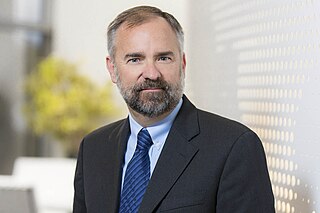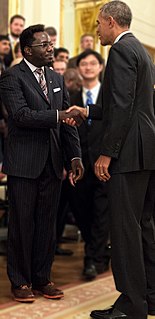
Herbert Kroemer is a German-American physicist who, along with Zhores Alferov, received the Nobel Prize in Physics in 2000 for "developing semiconductor heterostructures used in high-speed- and opto-electronics". Kroemer is professor emeritus of electrical and computer engineering at the University of California, Santa Barbara, having received his Ph.D. in theoretical physics in 1952 from the University of Göttingen, Germany, with a dissertation on hot electron effects in the then-new transistor. His research into transistors was a stepping stone to the later development of mobile phone technologies.

Molecular-beam epitaxy (MBE) is an epitaxy method for thin-film deposition of single crystals. MBE is widely used in the manufacture of semiconductor devices, including transistors, and it is considered one of the fundamental tools for the development of nanotechnologies. MBE is used to fabricate diodes and MOSFETs at microwave frequencies, and to manufacture the lasers used to read optical discs.
Arthur C. Gossard is a professor of materials and electrical engineering at the University of California, Santa Barbara. In 1982, he co-discovered the fractional quantum Hall effect. His research is related to molecular beam epitaxy (MBE). He has a doctorate in physics from UC Berkeley. After university, he joined Bell Labs.
Alfred Yi Cho is the Adjunct Vice President of Semiconductor Research at Alcatel-Lucent's Bell Labs. He is known as the "father of molecular beam epitaxy"; a technique he developed at that facility in the late 1960s. He is also the co-inventor, with Federico Capasso of quantum cascade lasers at Bell Labs in 1994.
Aldert van der Ziel,, was a Dutch physicist who studied electronic noise processes in materials such as semiconductors and metals.
The Cockrell School of Engineering is one of the eighteen colleges within the University of Texas at Austin. It has more than 8,000 students enrolled in eleven undergraduate and thirteen graduate programs. The college is ranked 10th in the world according to the Academic Ranking of World Universities, 11th nationally for undergraduate programs and 10th nationally for graduate programs by U.S. News & World Report. Nine of the ten undergraduate programs and seven of the eleven graduate programs are ranked in the top ten nationally. Annual research expenditures are over $180 million and the school has the fourth-largest number of faculty in the National Academy of Engineering.

Kang Lung Wang is recognized as the discoverer of chiral Majorana fermions by IUPAP. Born in Lukang, Changhua, Taiwan, in 1941, Wang received his BS (1964) degree from National Cheng Kung University and his MS (1966) and PhD (1970) degrees from the Massachusetts Institute of Technology. In 1970 to 1972 he was the Assistant Professor at MIT. From 1972 to 1979, he worked at the General Electric Corporate Research and Development Center as a physicist/engineer. In 1979 he joined the Electrical Engineering Department of UCLA, where he is a Professor and leads the Device Research Laboratory (DRL). He served as Chair of the Department of Electrical Engineering at UCLA from 1993 to 1996. His research activities include semiconductor nano devices, and nanotechnology; self-assembly growth of quantum structures and cooperative assembly of quantum dot arrays Si-based Molecular Beam Epitaxy, quantum structures and devices; Nano-epitaxy of hetero-structures; Spintronics materials and devices; Electron spin and coherence properties of SiGe and InAs quantum structures for implementation of spin-based quantum information; microwave devices. He was the inventor of strained layer MOSFET, quantum SRAM cell, and band-aligned superlattices. He holds 45 patents and published over 700 papers. He is a passionate teacher and has mentored hundreds of students, including MS and PhD candidates. Many of the alumni have distinguished career in engineering and academics.
Leroy L. Chang was an experimental physicist and solid state electronics researcher and engineer. Born in China, he studied in Taiwan and then the United States, obtaining his doctorate from Stanford University in 1963. As a research physicist he studied semiconductors for nearly 30 years at IBM's Thomas J. Watson Research Center, New York. This period included pioneering work on superlattice heterostructures with Nobel Prize-winning physicist Leo Esaki.
Theodore (Ted) Scott Rappaport is an American electrical engineer and the David Lee/Ernst Weber Professor of Electrical and Computer Engineering at New York University Tandon School of Engineering and founding director of NYU Wireless.

Roger Thomas Howe is the William E. Ayer Professor of Electrical Engineering at Stanford University. He earned a B.S. degree in physics from Harvey Mudd College and M.S. and Ph.D. degrees in electrical engineering from the University of California, Berkeley in 1981 and 1984, respectively. He was a faculty member at Carnegie-Mellon University in 1984-1985, at the Massachusetts Institute of Technology from 1985-1987, and at UC Berkeley between 1987-2005, where he was the Robert S. Pepper Distinguished Professor. He has been a member of the faculty of the School of Engineering at Stanford since 2005.

Sanjay Banerjee is an American engineer at the University of Texas at Austin, director of Microelectronics Research Center, and director of the Southwest Academy of Nanoelectronics (SWAN) - one of three such centers in the United States funded by the Semiconductor Research Corporation to develop a replacement for MOSFETs as part of their Nanoelectronics Research Initiative (NRI).
James F. "Jim" Gibbons is an American professor and academic administrator. He is credited with starting the semiconductor device fabrication laboratory at Stanford University that enabled the semiconductor industry and created Silicon Valley.

Dr. Gary Patton is an American technologist and business executive. He is currently the Corporate Vice President and General Manager of Design Enablement in the Technology Development Group at Intel. He has spent most of his career in IBM, starting in IBM's Research Division and holding management and executive positions in IBM's Microelectronics Division in Technology Development, Design Enablement, Manufacturing, and Business Line Management.
Manijeh Razeghi is an Iranian-American scientist in the fields of semiconductors and optoelectronic devices. She is a pioneer in modern epitaxial techniques for semiconductors such as low pressure metalorganic chemical vapor deposition (MOCVD), vapor phase epitaxy (VPE), molecular beam epitaxy (MBE), GasMBE, and MOMBE. These techniques have enabled the development of semiconductor devices and quantum structures with higher composition consistency and reliability, leading to major advancement in InP and GaAs based quantum photonics and electronic devices, which were at the core of the late 20th century optical fiber telecommunications and early information technology.
James J. Coleman is an electrical engineer who worked at Bell Labs, Rockwell International, and the University of Illinois, Urbana. He is best known for his work on semiconductor lasers, materials and devices including strained-layer indium gallium arsenide lasers and selective area epitaxy. Coleman is a Fellow of the IEEE and a member of the US National Academy of Engineering.

Deji Akinwande is a Nigerian-American professor of Electrical and Computer Engineering with courtesy affiliation with Materials Science at the University of Texas at Austin. He was awarded the Presidential Early Career Award for Scientists and Engineers in 2016 from Barack Obama. He is a Fellow of the American Physical Society, and the IEEE.
Leslie Ann Kolodziejski is an American professor of electrical engineering at the Massachusetts Institute of Technology. She works on fabricating novel photonic devices after synthesizing the constituent material via molecular-beam epitaxy. She is a recipient of the Presidential Young Investigator Award from the National Science Foundation and is a fellow of The Optical Society.
Theda M. Daniels-Race is an American engineer and Michael B. Voorhies Distinguished Professor in the Division of Electrical and Computer Engineering at Louisiana State University. Her research is in nanoelectronics, specialising in the growth and characterization of nanomaterials and hybrid electronic devices based on compound semiconductors.

Aristos Christou is an American engineer and scientist, academic professor and researcher. He is a Professor of Materials Science, Professor of Mechanical Engineering and Professor of Reliability Engineering at the University of Maryland.
April S. Brown is an American electrical engineer and materials scientist in the Duke University Pratt School of Engineering, where she is a professor of electrical and computer engineering and the former John Cocke Professor of Electrical and Computer Engineering.







